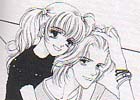Mars
| Genre: Romance | ||
| Length: 15 Volumes | ||
| Allegiance: Kodansha Ltd./Mixx Entertainment, Inc. | ||
| Mangaka: Soryo Fuyumi | ||
| Vintage: 1996-2000 | ||
| Intelligence Agency Report by: I | ||
| Aso Kira, a shy artist, first speaks to womanizing motorcyclist Kashino Rei when he asks directions to a nearby hospital to visit his injured friend. She soon becomes intrigued by him and his peculiar life and asks him to model for her drawings. As Kira and Rei fall in love and become closer, both are forced to face major obstacles and finally clean out the skeletons in their respective closets. | ||
|
|
||
| Research Agent Report by: I | ||
| Plot Characters Impact Visual |
8.50 9.25 9.25 8.50 |
|
| Overall | 9.00 | |
| (not an average) | ||
| My first impression of Mars was one with few expectations: the story sounded average, the characters would probably be cookie-cutter replicas of their angsty shoujo predecessors, and the art was just weird. However, once I began to read it I was pleasantly surprised by everything about the title; the twists thrown into the standard storyline, the dimensions given to the characters, and the unique art style and layouts Soryo-sensei incorporates all give the manga a special flair of its own.
The artwork for Mars is what first caught my attention. Soryo-sensei’s way of drawing is like none other; her character designs strike a perfect balance between realism and contemporary manga styles. It’s also interesting to see the art slowly improve as time passes; by the end of the series, the already decent art has changed into a beautiful, clean style that’s a pleasure to behold. The layouts succeed at being as original as the artwork is, but in the first few books, they’re almost too much for the eyes. Too many panels are placed on each page, and they go in every which way. All this really accomplishes is making the pages seem uncomfortably cramped. However, this problem is almost completely solved before the end of the fifth volume, and the layouts from that point forward are poetry in motion. Mars’ plot is, at a glance, so typical that is couldn’t possibly stand out from all the other sappy and melodramatic shoujo plotlines out there. Girl and boy meet, girl and boy have love rivals, girl and boy face traumatizing pasts and strange family ties. What makes this story different is how the characters interact with the challenges presented to them. Rather than individual conflicts simply serving as fodder to get the title through another chapter, each new obstacle slowly peels off Rei and Kira’s layers one by one. As each layer is removed, their insecurities, imperfections, and ways of dealing with their morbid pasts are shown and then placed to the side until all that’s left of them is their core, their sense of self. Although the plot is at heart a common one, the characters give the situations fresh, new energy. Of course, for characters to drive a plot one would need them to be fairly involving. Mars has no shortage of these; Rei, Kira, and the people who try to force themselves into their lives are fleshed out almost to perfection. Their motivations are made clear, and the emotions conveyed by them are deeper than those you’d find in the typical shoujo manga. One of the words commonly used to describe Mars’ characters is “realistic,” and I couldn’t agree more. The characters act like real people rather than idealized plot devices, and you can relate to their emotions surprisingly well. My only complaint is that a few of the side characters seem underdeveloped compared to the rest of the cast. A bit more depth to characters like Tatsuya may have been beneficial to the story. Mars goes above and beyond many of the other romance-oriented shoujo titles of today. Its characters, its art, and its story all give it a life of its own and make it a manga that should not be passed up.
|
||




